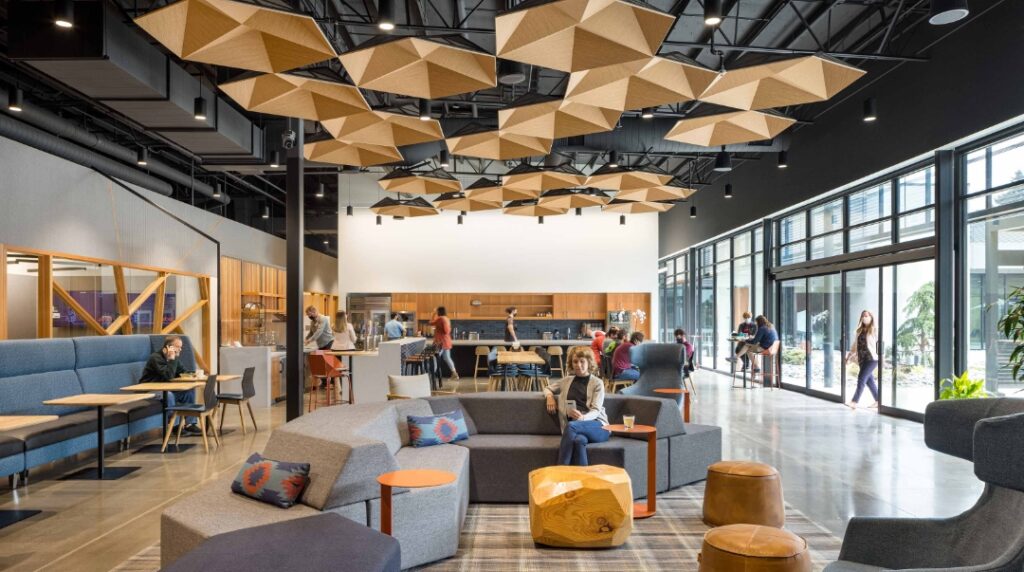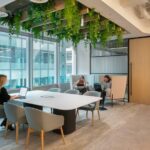Think back to a few years, when all offices felt the same. White walls, grey carpeting, and rows of the same desks beneath buzzing fluorescent lights. Useful, maybe, but not inspirational. The epidemic changed everything. Companies must reassess what offices are for because of hybrid work, and by 2025, the discourse will have gone much farther. Workspaces are more than simply places to sit and work; they are locations that affect how people feel, work together, and do their jobs.
So, what is changing? What is making this change happen? Let’s look at eight of the most important design trends that are affecting workstations this year.
1. Flexibility First
Rigid layouts don’t cut it anymore. Not when some people come in three days a week, others pop in occasionally, and teams gather only when collaboration makes sense. Offices in 2025 are built around movement.
Furniture is lighter and modular. Partitions can be wheeled in or folded away. One corner might host a casual chat in the morning and a strategy session by the afternoon. The idea is simple: the office adapts to the work, not the other way round.
2. Sustainability Without Compromise
Sustainability isn’t a “trend” in the old sense; it’s an expectation. Businesses can’t afford to ignore it, and staff, particularly younger employees, are vocal about it.
Recycled flooring, reclaimed timber, energy-efficient lighting, paints without harsh chemicals, you see them everywhere now. Offices are also designed to use more daylight, which not only cuts energy costs but makes people feel better.
3. Biophilic Design Becomes the Norm
Humans need nature. Put someone in a windowless box with artificial lighting and watch their energy slump. In 2025, biophilic design, basically, bringing the outside in, is everywhere.
Green walls, indoor plants, water features, bamboo textures, and open windows for fresh air. It’s not about decoration, it’s about well-being. Employees in nature-inspired spaces tend to be calmer, more focused, and less stressed. And employers know happier staff means better results.
4. Technology You Don’t Notice
For years, offices tried to show off their tech, screens, wires, and docks everywhere. It looked impressive but rarely worked smoothly. Now, the best technology is invisible.
Charging is incorporated into the desks. Screens connect wirelessly, so there are no uncomfortable wires. There are cameras and sound systems in meeting rooms that make people who are working from home feel like they are there. AI changes the lighting, air quality, and even the temperature of the space without you knowing it. The fewer people who notice the systems, the better they’re working.
5. Wellbeing Is Built In
Finally, companies understand that health and safety are not just nice things to have; they are necessary. People won’t spend time in places that make them tired. Offices in 2025 are made on purpose to keep stress levels low and comfort levels high.
There are quiet places where you may concentrate or meditate. Furniture that is ergonomic is the basis, not the upgrade. Lighting works like natural cycles. Panels that cut down on noise make open-plan spaces bearable. The colours are also planned: soothing blues and greens in peaceful areas and warmer colours in places where people work together.
6. A Personal Touch
Hot-desking isn’t popular with everyone, and for good reason. No one likes walking into an office that feels like it belongs to no one. In 2025, office interior designers are striking a balance: flexibility with touches of personalisation.
Lockers give staff a place for their things. Smart desks remember individual settings. Teams are encouraged to shape small areas around their identity, without creating clutter. These details may sound minor, but they give employees a sense of belonging, even in a shared environment.
7. Inclusivity at the Centre
More than simply easy-to-reach entrances make a workplace inclusive. It means designing for every ability and every working style. Adjustable desks and seating, clear high-contrast signage, layouts that consider wheelchair users, and quiet spaces for neurodiverse employees are all becoming standard.
Companies are realising it’s not just about legal compliance. It’s about culture. A workplace that feels welcoming to everyone says more about a business than any brochure or mission statement.
8. Bold Design, Human Feel
Here’s something you’ll notice straight away: offices aren’t afraid of personality anymore. The bland, neutral look is fading. Expect bolder accent colours, statement lighting, and creative art pieces that spark conversation.
But “bold” doesn’t mean uncomfortable. The sharp, corporate coldness of glass-and-metal design is being softened. Rounded corners, warmer fabrics, textured finishes, they balance the energy. Employees spend hours here, so offices are now designed to inspire without overwhelming.
Why These Shifts Matter
Are these just style choices? No, not really. They reveal changes that are occurring on a deeper level. Hybrid jobs require people to be flexible. Knowing about climate change makes it vital to be sustainable. Mental health made people pay more attention to their health. And being inclusive was no longer a suggestion; it was a must.
That’s why many organisations are working with experienced professionals, like office interior designers in Hyderabad, who understand how to combine aesthetics with function. And of course, seasoned interior designers everywhere are guiding businesses through this change. It’s not just about how an office looks anymore. It’s about how it works, how it feels, and what it says about the company.
Looking Ahead
The future workplace isn’t a set piece. It’s a living environment that shifts with people’s needs. Businesses that invest in this now will stand out. They’ll attract talent, keep it, and create cultures where people want to spend time in the office. Those that don’t? They risk being left with spaces that feel out of step with the world around them.
Final Thought
Workspaces in 2025 aren’t background scenery. They play an active role in shaping culture, mood, and performance. Done well, design lifts people. Done poorly, it drags them down.
That’s the real story behind these trends. Offices are finally catching up with the simple truth: people do their best work when they feel supported by the space around them.



